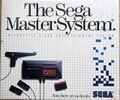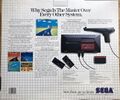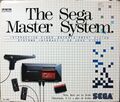Difference between revisions of "Master System consoles in North America"
From Sega Retro
m (Text replace - "Category:Master System Hardware" to "Category:Master System hardware") |
|||
| Line 1: | Line 1: | ||
Though the [[Sega Master System]] always played second-best to the Nintendo Entertainment System (so much so that few even remember the Master System's existence in this region), many bundles and console revisions were given to the North American audience. | Though the [[Sega Master System]] always played second-best to the Nintendo Entertainment System (so much so that few even remember the Master System's existence in this region), many bundles and console revisions were given to the North American audience. | ||
| − | + | There are three confirmed "sets" of North American Master System; early consoles distributed by [[Sega]], late 80s consoles distributed by [[Tonka]], and a third set for the redesgined Master System II, also distributed by Sega. Canada changed packaging when the US changed distributors, but all consoles in that country were distributed by [[Irwin Electonics]]. | |
| + | |||
| + | Contrary to popular belief, until the advent of the Sega Master System II, Sega did not call the console the "Sega Master System" in North America. Instead the console was referred to as the "Sega System", a rather vague and confusing title which was inevitably scrapped. The console unit itself is often referred to as the "Power Base" (similar to the NES' "Control Deck"), though for unknown reasons the text printed on the top of the unit reads "Master System/Power Base". The "Master System" name clearly stuck, and became the official title for the console in later revisions. | ||
| + | |||
| + | Though there are similarities with European packaging, North American models are easier to spot than one might expect. | ||
| + | |||
==The Sega Base System== | ==The Sega Base System== | ||
| − | + | When the Master System debuted in North America in 1986, two packages were available, the simpler, cheaper option being this "Sega Base System". In this initial "set", most names are prefixed with the word "The". North American bundles can be identified by the blue square patterns on the right hand side. | |
| − | + | The Base System contains merely a Power Base and a couple of controllers. Sega were not particularly honest in this region when it came to packaging - despite the existence of a cartridge on the front, there are no games included. | |
<gallery> | <gallery> | ||
File:TSBS US Box Front.jpg|Front of box | File:TSBS US Box Front.jpg|Front of box | ||
Revision as of 05:29, 28 May 2012
Though the Sega Master System always played second-best to the Nintendo Entertainment System (so much so that few even remember the Master System's existence in this region), many bundles and console revisions were given to the North American audience.
There are three confirmed "sets" of North American Master System; early consoles distributed by Sega, late 80s consoles distributed by Tonka, and a third set for the redesgined Master System II, also distributed by Sega. Canada changed packaging when the US changed distributors, but all consoles in that country were distributed by Irwin Electonics.
Contrary to popular belief, until the advent of the Sega Master System II, Sega did not call the console the "Sega Master System" in North America. Instead the console was referred to as the "Sega System", a rather vague and confusing title which was inevitably scrapped. The console unit itself is often referred to as the "Power Base" (similar to the NES' "Control Deck"), though for unknown reasons the text printed on the top of the unit reads "Master System/Power Base". The "Master System" name clearly stuck, and became the official title for the console in later revisions.
Though there are similarities with European packaging, North American models are easier to spot than one might expect.
Contents
The Sega Base System
When the Master System debuted in North America in 1986, two packages were available, the simpler, cheaper option being this "Sega Base System". In this initial "set", most names are prefixed with the word "The". North American bundles can be identified by the blue square patterns on the right hand side.
The Base System contains merely a Power Base and a couple of controllers. Sega were not particularly honest in this region when it came to packaging - despite the existence of a cartridge on the front, there are no games included.
The Sega Master System (with Hang-On and Safari Hunt)
The other option, the Sega Master System, was more thoughtful, giving the user two control pads, a Light Phaser and both Hang-On and Safari Hunt built in.
- TSMSHOSH US 1.jpg
Contents of box
The Sega Master System (with Hang-On)
At some point, Sega redefined what it was to be a "Master System". This version of the Master System simply contains Hang-On, which was built-in to the console, and two control pads. We are unsure exactly when this bundle was released, so it may have been earlier than the above.
Sega Base System (with Hang-On)
These "second generation" Master System bundles arrived a couple of years down the line. These would be the mould for most international models. They have a different typeface describing the system (underlined in colour) and the "SEGA" logo replaces the "The Sega" text seen in earlier models. From this point onwards all bundles were called "Sega xxx System" as opposed to "The Sega xxx System". It's also where things start to get complicated.
The "Base System" survived, but the bundle was changed so that it contained a copy of Hang-On (mis-represented by the screenshot on the front of the box) as well as two control pads. This means the new "Base System" is identical to one of the old "Master System"s.
Sega SegaScope 3-D System
Sega also released a model attempting to push their 3-D Glasses accessory. The "SegaScope 3D System" package inlcudes were two controllers, a Light Phaser and a pair of 3-D glasses.
Master System Plus
Another pre-Tonka model, now bundled with a Light Phaser and Safari Hunt and Hang On built in.
Canada
The Sega Master System
Canada's history is similar to the US', except they dropped any name that wasn't "Sega Master System". Consoles were distributed by Irwin Toy, a practise that would continue until shortly after the Sega Mega Drive's release. This model was released in 1986 and is identical to the first US "Sega Master System" model. Canadian releases can be distinguished by the IRWIN logo in the top left.
Sega Master System
Canada also saw their packaging redesigned, with Safari Hunt and Hang On built in for good measure.
| Sega Master System | |
|---|---|
| Topics | Sega Master System | Technical Specifications (Hardware Comparison) | History | Boot ROM | Magazine articles | Promotional material | Merchandise |
| Hardware | Asia | North America | Western Europe | Eastern Europe | South America | Australasia | Africa Sega Mark III | Sega Game Box 9 | Master System Girl | Master System Super Compact | Kiosk | Sega System E |
| Add-ons | Demo Unit II | Telecon Pack | FM Sound Unit | 3-D Glasses |
| Controllers | SJ-152 | Control Pad | 3-D Glasses | Control Stick | Handle Controller | Light Phaser | Paddle Control | Rapid Fire Unit | Sports Pad | SG Commander |
| Misc. Hardware | Action Replay | Card Catcher | Action Case | Freedom Connection | Playkit |
| Unreleased | Floppy Disk Drive |
| Consoles-on-a-chip | Arcade Gamer Portable | TF-DVD560 | DVD Karaoke Game DVT-G100 | Fun Play 20-in-1 | Handheld Electronic Games | Master System 3 Collection | Master System 3 | Master System Evolution | Master System Handy | PlayPal Plug & Play | Poga |







